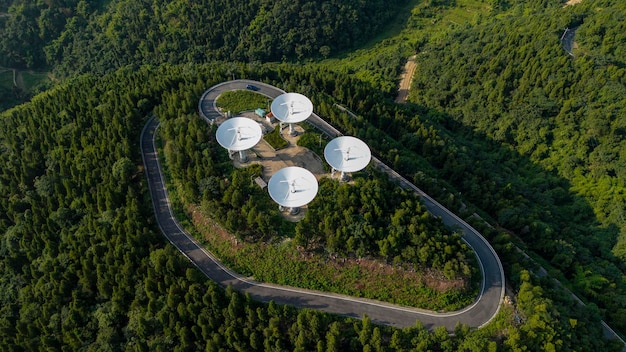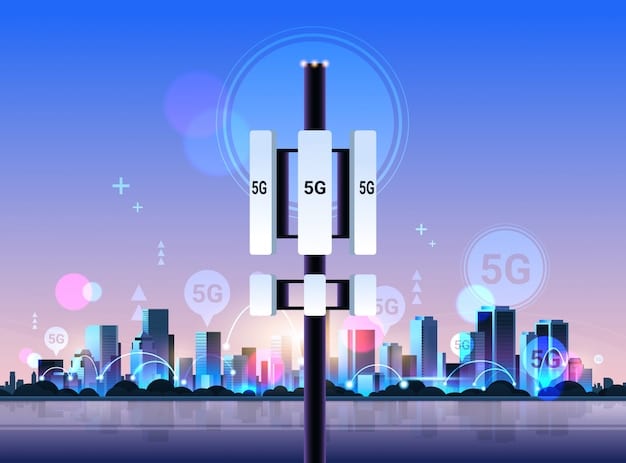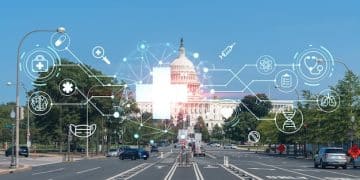5G Infrastructure Bill: Rural Broadband Access by 2026

The new 5G Infrastructure Bill aims to significantly enhance rural broadband access by 2026 through substantial investments in underserved areas, promoting digital equity and economic development across the United States.
The quest for reliable, high-speed internet access has long been a defining challenge for rural communities across the United States. As technological advancements accelerate, particularly in wireless communication, the digital divide between urban and rural areas has become increasingly stark. A significant legislative effort, the 5G Infrastructure Bill, seeks to bridge this divide, promising transformative changes. Understanding How Will the New 5G Infrastructure Bill Impact Rural Broadband Access by 2026? requires examining its core provisions, target areas, and the ambitious timelines set forth to ensure equitable connectivity for all.
Understanding the Need: The Rural Broadband Gap
The digital divide is more than just an inconvenience; it represents a fundamental barrier to economic opportunity, educational advancement, and access to essential services. For millions of Americans living in rural areas, reliable internet remains an elusive dream, far from the ubiquitous connectivity enjoyed by their urban counterparts. This disparity affects everything from remote learning and telemedicine to agricultural innovation and small business growth.
Historically, the cost-prohibitive nature of deploying fiber-optic infrastructure across vast, sparsely populated areas has been a major deterrent for private telecommunication companies. The return on investment in these regions often doesn’t justify the immense upfront capital expenditure. Consequently, many rural communities are left with slow, unreliable, or nonexistent internet services, hindering their ability to participate fully in the modern digital economy. This lack of robust broadband has exacerbated existing inequalities, making it difficult for rural businesses to compete, for students to access online educational resources, and for residents to utilize telehealth services. The economic implications are severe, as businesses are hesitant to relocate or expand in areas lacking essential digital infrastructure, leading to a stagnation of local economies and a continuation of the cycle of underdevelopment.
The Persistent Challenge of Connectivity
The challenge extends beyond mere availability. Even in areas where some form of internet access exists, it is often inadequate.
- Low Speeds: Many rural connections barely meet the federal definition of broadband (25 Mbps download / 3 Mbps upload), which is increasingly insufficient for modern demands.
- High Costs: When available, rural broadband plans can be significantly more expensive than urban equivalents for inferior service.
- Reliability Issues: Inclement weather, aging infrastructure, and limited network redundancy often lead to frequent outages.
Addressing this multifaceted issue requires a comprehensive, strategic approach that incentivizes infrastructure development while ensuring affordability and long-term sustainability. The 5G Infrastructure Bill aims to provide tailored solutions to these enduring problems, marking a crucial step towards digital inclusion.
Overview of the 5G Infrastructure Bill and its Funding Mechanisms
The 5G Infrastructure Bill, often part of broader infrastructure legislation, represents a monumental commitment by the U.S. government to modernize and expand the nation’s digital backbone. Its core objective is to accelerate the deployment of high-speed broadband, particularly focusing on underserved and unserved areas. The bill outlines substantial financial allocations, leveraging a mix of direct grants, low-interest loans, and partnerships with private entities to achieve its ambitious goals. These funding mechanisms are designed to mitigate the financial risks associated with rural deployments, thereby incentivizing telecommunications providers to extend their networks into areas previously deemed unprofitable. The legislation emphasizes a “future-proof” approach, encouraging the deployment of fiber-optic cables and 5G-ready infrastructure that can meet the escalating demands of future technologies, rather than simply patching existing gaps. This long-term vision aims to prevent technological obsolescence and ensure sustainable connectivity for decades to come.
Key Funding Streams and Programs
The bill’s impact hinges on several critical funding streams and programs, each designed to address specific aspects of the broadband deployment challenge.
- Broadband Equity, Access, and Deployment (BEAD) Program: This flagship program, managed by the National Telecommunications and Information Administration (NTIA), is allocated tens of billions of dollars. States receive grants to fund broadband deployment projects, with a strong emphasis on unserved and underserved locations. The BEAD program requires states to develop comprehensive plans, ensuring projects are strategically aligned with local needs and priorities.
- Middle Mile Grant Program: Recognizing that direct connections to homes are only part of the solution, this program invests in “middle mile” infrastructure, which involves the high-capacity fiber lines that connect local networks to the broader internet backbone. Improving middle mile capacity reduces costs for last-mile providers and enhances overall network resilience.
- Tribal Broadband Connectivity Program: Acknowledging the unique challenges faced by tribal communities, this dedicated program provides funding directly to tribal governments for broadband deployment and adoption initiatives on tribal lands.
The legislation also includes provisions for digital equity, ensuring that the benefits of expanded broadband reach all segments of the population, including low-income households, veterans, and individuals with disabilities. This comprehensive funding approach is critical for overcoming the economic barriers that have historically prevented widespread rural broadband deployment.
Targeted Areas and Project Timelines for 2026
The 5G Infrastructure Bill is explicitly designed to address the most critical gaps in broadband access, focusing on areas identified as “unserved” or “underserved.” An unserved location is generally defined as one without access to reliable internet service at speeds of 25 Mbps download and 3 Mbps upload, while an underserved location falls short of more contemporary standards like 100 Mbps download and 20 Mbps upload. The bill mandates a data-driven approach to identify these specific locations, utilizing updated broadband maps that provide granular detail on service availability across the nation. This level of precision is crucial for ensuring that funding is directed where it is most needed, preventing over-subsidization in already served areas and maximizing the impact of every dollar invested. The ambitious target date of 2026 for significant impact reflects an urgency to close the digital divide as quickly as possible.
Strategic Prioritization of Rural Regions
States, in coordination with the NTIA, are developing detailed plans that prioritize deployment in:
- Remote Rural Communities: Areas with extremely low population density where traditional economic models for broadband expansion have failed.
- Tribal Lands: Recognizing historical disparities, specific emphasis is placed on ensuring robust connectivity for Native American communities.
- Areas with Agricultural Importance: Supporting precision agriculture and smart farming initiatives requires high-speed internet, making these regions a priority.
The timeline for implementation is aggressive, reflecting the urgency of the issue. By 2026, the goal is not merely to begin projects but to show tangible progress in connecting a significant portion of these targeted areas. This involves several phases: initial planning and mapping (which largely conclude by late 2023/early 2024), grant application and allocation (throughout 2024), and active construction and deployment (from late 2024 through 2026). While challenges such as supply chain issues and labor shortages may impact exact deadlines, the legislative framework provides incentives to expedite deployment.
The bill also supports innovative deployment strategies, recognizing that a “one-size-fits-all” approach may not be effective. This includes promoting the use of fixed wireless access (FWA) and satellite technologies where fiber deployment is economically unfeasible, while still prioritizing future-proof fiber solutions where possible. The focus is on ensuring that by 2026, a substantial number of rural households and businesses will have not just access, but genuinely reliable, high-speed broadband that meets their current and future needs.
Technological Focus: 5G and Fiber Deployment Synergies
While the bill is named the “5G Infrastructure Bill,” its scope extends beyond just fifth-generation wireless technology. A core tenet of the legislation is the recognition that a robust 5G network relies heavily on a foundational fiber-optic backbone. 5G, particularly its higher frequency bands, requires dense arrays of small cells connected by fiber to deliver its promised speeds and low latency. Therefore, the bill primarily invests in extending fiber infrastructure to support both fixed broadband access for homes and businesses and to serve as the critical “backhaul” for 5G wireless networks. This synergistic approach ensures that investments serve multiple purposes, creating a more resilient and versatile national broadband infrastructure. The integration of 5G capabilities into this expanded fiber network means that rural areas will not only gain better traditional internet access but will also be primed for the advanced applications and services that 5G enables, such as smart agriculture, remote robotics, and enhanced IoT connectivity. This forward-looking strategy positions rural economies to benefit from the next wave of digital transformation.
The Indispensable Role of Fiber Optics
Fiber-optic cables are the literal backbone of modern telecommunications.
- Speed and Capacity: Fiber offers unparalleled data transmission speeds and capacity, making it future-proof for decades to come.
- Latency: Low latency, critical for real-time applications and 5G performance, is inherent to fiber.
- Reliability: Fiber is less susceptible to electromagnetic interference and weather-related disruptions than copper or traditional wireless.
The bill incentivizes “fiber-to-the-home” (FTTH) deployments wherever feasible, recognizing it as the gold standard for broadband connectivity. For areas where FTTH is not immediately viable due to extreme costs or geographic challenges, the bill also supports fixed wireless access (FWA) solutions, including those utilizing 5G technology, which can deliver significantly improved speeds over older wireless standards. These FWA deployments often rely on fiber-fed base stations, further solidifying the symbiotic relationship between 5G and fiber. By stimulating fiber construction, the bill ensures that the groundwork for both cutting-edge wired broadband and advanced 5G mobile services is laid simultaneously, maximizing the long-term impact of the investment. This dual focus ensures that rural areas receive not just basic connectivity, but access to the kind of high-performance networks that drive innovation and economic growth.
Potential Economic and Social Impacts by 2026
The widespread deployment of high-speed broadband in rural areas, significantly accelerated by the 5G Infrastructure Bill, is poised to unleash a cascade of positive economic and social impacts by 2026. Access to reliable internet is a fundamental enabler of economic activity in the 21st century. For rural economies, this means new opportunities for e-commerce, remote work, and the growth of technology-dependent industries that previously bypassed these regions. Businesses can expand their market reach, tap into larger talent pools, and streamline operations, fostering innovation and competitiveness. Socially, the implications are equally profound, addressing critical needs in healthcare, education, and community engagement. By bridging the digital divide, the bill is not just connecting homes; it is connecting communities to a brighter, more equitable future, ensuring they are not left behind in the rapidly evolving digital landscape.

Transformative Effects on Rural Livelihoods
The economic benefits alone are substantial:
- Job Creation: Construction and maintenance of new infrastructure, alongside the growth of new businesses, will generate thousands of jobs.
- Increased Economic Activity: Enhanced connectivity can lead to higher property values, local business expansion, and improved tax revenues for rural municipalities.
- Attraction of Remote Workers: Rural areas with good broadband can become attractive hubs for remote workers seeking a better quality of life, boosting local economies.
Beyond economics, the social improvements are vital. Telemedicine becomes a viable option, allowing rural residents to access specialized medical care from their homes, reducing travel burdens and improving health outcomes. Education is revolutionized, with students in previously underserved areas gaining access to online learning platforms, virtual field trips, and a wealth of digital resources. Communities can strengthen their social fabric by leveraging broadband for civic engagement, emergency services communication, and cultural exchange. The ability to stay connected with family and friends, access entertainment, and participate in online communities also enhances overall quality of life. By 2026, these combined effects are expected to lead to more vibrant, resilient, and connected rural communities. This holistic approach to infrastructure development acknowledges that internet access is no longer a luxury but a fundamental utility.
Challenges and Mitigations for Deployment
While the ambitions of the 5G Infrastructure Bill are significant, realizing its full potential by 2026 will undoubtedly encounter various challenges. Large-scale infrastructure projects are inherently complex, particularly when dealing with vast geographic areas and diverse local conditions. Overcoming these hurdles will require coordinated efforts from federal, state, and local governments, as well as private industry. Key challenges include ensuring adequate skilled labor, navigating complex permitting processes, managing supply chain disruptions for crucial components, and addressing the unique topographical or environmental considerations in remote areas. Furthermore, the success of the bill hinges not only on physical deployment but also on ensuring affordability and digital literacy for end-users. Without effective mitigation strategies, these challenges could slow deployment, increase costs, and ultimately diminish the intended impact, preventing the bill from fully closing the rural digital divide.
Addressing Potential Roadblocks
Several proactive measures are being implemented or considered to mitigate these challenges:
- Workforce Development: Programs are being initiated to train a skilled workforce to build and maintain the new broadband infrastructure, addressing potential labor shortages.
- Permitting Streamlining: Efforts are underway to rationalize and expedite federal and state permitting processes to accelerate construction timelines.
- Supply Chain Resiliency: Prioritizing domestic manufacturing and diversifying international suppliers are strategies to ensure a consistent flow of equipment and materials.
Another significant challenge is ensuring “dig once” policies are adopted, where new infrastructure (like roads or sewage lines) includes conduits for fiber at the same time, reducing future disruption and cost. Lastly, the bill also acknowledges the challenge of digital adoption, not just availability. Funding includes provisions for programs that assist low-income households with the cost of broadband service and devices, and initiatives that provide digital literacy training. By anticipating and proactively addressing these multifaceted challenges, the 5G Infrastructure Bill aims to ensure that its ambitious goals for rural connectivity are met efficiently and effectively by the 2026 deadline. This integrated approach, combining infrastructure development with support for end-users, is crucial for achieving true digital equity.
Long-Term Outlook: Beyond 2026 and Evolving Connectivity Needs
While 2026 marks a crucial milestone for the 5G Infrastructure Bill’s impact on rural broadband, the journey towards universal and future-proof connectivity extends far beyond this initial target. The pace of technological change shows no signs of slowing, meaning that what constitutes “high-speed” today may be considered inadequate in just a few years. Therefore, the long-term outlook for rural broadband must involve continuous investment, adaptability, and a proactive approach to emerging technologies. The infrastructure built under this bill is intended to be foundational, capable of supporting subsequent generations of wireless and wired technologies, but sustained commitment will be necessary to keep rural America at the forefront of the digital age. This ongoing evolution will require flexible policy frameworks, continued public-private partnerships, and a consistent focus on the changing needs of rural communities to ensure long-term digital sustainability.

Preparing for Future Demands
Key aspects of the long-term outlook include:
- Scalability of Infrastructure: Designing networks with built-in capacity for upgrades, such as readily accessible conduits for additional fiber, is crucial.
- Integration of New Technologies: As 6G and other wireless innovations emerge, flexible infrastructure will allow for seamless integration, avoiding costly overhauls.
- Sustainable Funding Models: Exploring diverse and sustainable funding models beyond initial grant programs will be essential for continuous improvements and maintenance.
Furthermore, the evolving needs of rural communities themselves will shape future connectivity goals. As precision agriculture becomes more prevalent, demanding real-time data processing from thousands of sensors, or as telehealth expands to incorporate advanced diagnostics and remote surgeries, the bandwidth requirements will soar. The long-term vision encompasses a dynamic digital ecosystem where rural areas are not just connected, but are active participants in technological innovation, driving economic growth and social progress. This commitment extends to fostering local technical expertise and digital literacy programs that empower residents to fully leverage the advanced connectivity. The 5G Infrastructure Bill is a powerful catalyst, but sustained effort and foresight will ensure that rural America remains digitally inclusive and competitive for generations to come.
| Key Impact | Brief Description |
|---|---|
| 🚀 Enhanced Connectivity | Bill targets significant improvement in rural broadband speeds and reliability, especially 5G and fiber. |
| 💰 Economic Growth | Anticipated boost in local economies, job creation, and attraction of remote workers. |
| 🏥 Social Benefits | Improved access to telemedicine, remote education, and enhanced community services. |
| 🚧 Deployment Challenges | Requires overcoming hurdles like labor shortages, supply chain issues, and complex permitting. |
Frequently Asked Questions About 5G and Rural Broadband
▼
The 5G Infrastructure Bill is a legislative initiative, often part of broader infrastructure acts, aimed at funding the expansion of high-speed broadband, including 5G-ready fiber optics, to unserved and underserved areas across the United States. It allocates significant federal resources to address the digital divide and foster digital equity nationwide.
▼
By 2026, the bill is expected to have financed the deployment of new or upgraded broadband infrastructure, primarily fiber and 5G fixed wireless, in numerous rural communities. This will provide millions of previously disconnected or underserved households and businesses with access to reliable, high-speed internet, stimulating local economies and improving quality of life.
▼
Despite its name, the bill heavily emphasizes fiber optic deployment. 5G networks require robust fiber backhaul for optimal performance, so investing in fiber infrastructure simultaneously supports both high-speed wired access and advanced 5G wireless capabilities. The synergy ensures a future-proof network for many years to come.
▼
Key challenges include ensuring a sufficient skilled workforce for construction, navigating complex permitting processes, managing potential supply chain disruptions for equipment, and addressing environmental considerations in diverse terrains. Local and state coordination, along with strategic planning, are crucial for mitigating these obstacles and meeting deadlines.
▼
Beyond direct connectivity, rural areas can expect significant socio-economic benefits. These include improved access to remote work opportunities, enhanced telemedicine services, expanded educational resources for students, and new avenues for local business growth. Reliable broadband fosters community development and enhances overall digital inclusion.
Conclusion
The 5G Infrastructure Bill represents a pivotal moment in the ongoing effort to ensure equitable broadband access across the United States. Its strategic investment in both fiber and 5G technologies is designed to create a robust, future-proof digital infrastructure, particularly for long-underserved rural communities. By 2026, the ambitious goals set by this legislation aim to significantly narrow the digital divide, unlocking new economic opportunities, enhancing access to vital services like healthcare and education, and fostering stronger, more connected communities. While challenges persist in such a monumental undertaking, the coordinated effort by government and industry reflects a profound commitment to digital equity. The impact is poised to be transformative, ushering in an era where geographic location no longer dictates access to the essential digital tools of the 21st century.
“`html





